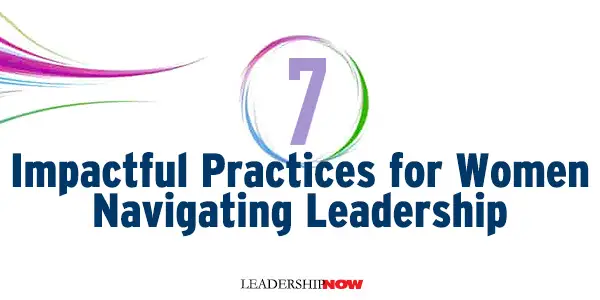 |
 |
04.15.22

7 Impactful Practices for Women Navigating Leadership
ARE you thriving as a leader? Arrive And Thrive: 7 Impactful Practices for Women Navigating Leadership is written by three successful leaders, Janet Foutty, Lynn Perry Wooten, and Susan MacKenty Brady. Together they offer seven key practices to thrive as a leader. Practice 1: Invest in Your Best Self This practice boils down to knowing yourself and is the foundational practice. When you know yourself—strengths and weaknesses—you can learn to lead from your best self. It really isn’t about loving yourself but having a grip on reality regarding your strengths and weaknesses and how they affect your leadership. Or how other people see you and where you might need to improve. Nevertheless, as the authors say, your greatest room for growth is in the areas of your greatest strengths. You want the bulk of your work to draw on your strengths, although not all of your work will. When we get kicked out of our best self (our flow) into any number of less productive places, it’s usually because something happened. This is when practice four comes into play—pausing to reflect. The reason you must practice mindfulness (noticing) and then pause as quickly as possible (other than all of the consequences for you and your relationships if you don’t) is because the best part of you just got hijacked by your own brain. These moments can turn into a lifetime of anger and fear-based psychological warfare, or these moments can turn into opportunities to practice compassion with self and others and ultimately leave you feeling at peace. War won’t get you back to your best self. Love will. You are in the driver’s seat. Practice 2: Embrace Authenticity Bring your whole self to work. “Being authentic self doesn’t mean we eschew filters and boundaries in our self-expression. It means we approach any challenge or opportunity from our best and most transparent self.” Expect that discovering and embracing your authentic self will feel beautiful and smooth only to a point—until you find yourself confronted with any number of obstacles that may result in: Practice 3: Cultivate Courage Commit to action. The practice of courage will enable you to overcome setbacks and lead more powerfully. Cultivating personal courage requires you to acknowledge what you don’t know, ask for help, and act despite risk of failure. All three actions are likely to invite feelings of discomfort and vulnerability. Practice 4: Foster Resilience “Resilience is doing well when you shouldn’t be doing well,” says the executive director of the Global Center for Resiliency, Amit Sood. It requires adaptability. The authors suggest becoming a positive deviant—that person who can find a better and more successful solution to the problem even though they have the same resources as the rest of the group. Fostering resilience means proactively preparing for the often unexpected twists and turns that life brings, and rising up through challenges stronger and wiser. Resilience is the ability to bounce back and adapt. With every bounce back, you become a better version of yourself. Practice 5: Inspire a Bold Vision Inspiring a bold vision begins by noticing. Discovering what needs to change and then taking steps to make it happen. A network for building a vision is not incidental. The offering of this practice builds down to believing in yourself and trusting your judgment as you enroll others, organize a path that will reach the desired destination, and be the one who harnesses the energy of others to achieve it. Practice 6: Create a Healthy Team Environment This practice is about personifying your organization’s values while creating a supportive, collaborative, and healthy environment. Leading from your best self, this practice is about getting others to lead from their best selves. Every individual brings something unique and powerful to the team, and conversely, every induvial retains areas where they are just not strong. Further, it is up to you (the leader) to work with the individual to help them know how they naturally excel, where they need help from teammates, and what shared goals or purpose they’re all using a strengths-based approach to achieve. Specifically, we suggest you use a strengths-based approach to intentionally promote effective delegation, successful partnerships, and deeper collaboration, among other outcomes. Practice 7: Lead Inclusively Being an inclusive leader means modeling it for others, knowing yourself, understanding your biases, and supporting others. As an inclusive leader, you can focus on what you do best and partner with others who are also bringing their best to the table. Together, you will discover more creative, compelling solutions, and you’ll do it from an approach that is much more sustainable. Inclusive leadership means going from the “me” to the “we” and creates a whole that is greater than the sum of its parts. All of these practices work to support each of the other ones. Although written specifically to women and for women, Arrive And Thrive offers valuable advice to anyone wishing to overcome these common obstacles and thrive in and out of the workplace. As Indra Nooyi writes in the book’s foreword, “the themes explored in this book, when viewed all together, wield immense power in helping anyone thrive in a leadership position.” 
Posted by Michael McKinney at 08:18 AM
|
BUILD YOUR KNOWLEDGE
 

How to Do Your Start-Up Right STRAIGHT TALK FOR START-UPS 
Grow Your Leadership Skills NEW AND UPCOMING LEADERSHIP BOOKS 
Leadership Minute BITE-SIZE CONCEPTS YOU CAN CHEW ON 
Classic Leadership Books BOOKS TO READ BEFORE YOU LEAD |